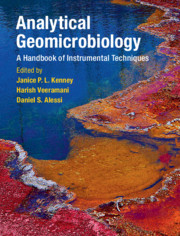Analytical Geomicrobiology A Handbook of Instrumental Techniques
Langue : Anglais
Coordonnateurs : Kenney Janice P. L., Veeramani Harish, Alessi Daniel S.

A comprehensive handbook outlining state-of-the-art analytical techniques used in geomicrobiology, for advanced students, researchers and professional scientists.
Geomicrobiology is the study of microbes and microbial processes and their role in driving environmental and geological processes at scales ranging from the nano, micron, to meter scale. This growing field has seen major advances in recent years, largely due to the development of new analytical tools and improvements to existing techniques, which allow us to better understand the complex interactions between microbes and their surroundings. In this comprehensive handbook, expert authors outline the state-of-the-art and emerging analytical techniques used in geomicrobiology. Readers are guided through each technique including background theory, sample preparation, standard methodology, data collection and analysis, best practices and common pitfalls, and examples of how and where the technique has been applied. The book provides a practical go-to reference for advanced students, researchers and professional scientists looking to employ techniques commonly used in geomicrobiology.
Foreword Kurt O. Konhauser; Part I. Standard Techniques in Geomicrobiology: 1. General geochemistry and microbiology techniques Sarrah Dunham-Cheatham and Yaqi You; Part II. Advanced Analytical Instrumentation: 2. The application of isothermal titration calorimetry for investigating proton and metal interactions on microbial surfaces Drew Gorman-Lewis; 3. Potentiometric titrations to characterize the reactivity of geomicrobial surfaces Daniel S. Alessi, Shannon L. Flynn, Md. Samrat Alam, Leslie J. Robbins and Kurt O. Konhauser; 4. Use of multi-collector ICP-MS for studying biogeochemical metal cycling Kai Liu, Lingling Wu and Sherry L. Schiff; Part III. Imaging Techniques: 5. Scanning probe microscopy Adam F. Wallace; 6. Applications of scanning electron microscopy in geomicrobiology Jeremiah Shuster, Gordon Southam and Frank Reith; 7. Applications of transmission electron microscopy in geomicrobiology Jeremiah Shuster, Gordon Southam and Frank Reith; 8. Whole cell identification of microorganisms in their natural environment with fluorescence in situ hybridization (FISH) Natuschka M. Lee; Part IV. Spectroscopy: 9. X-ray diffraction techniques Daniel K. Unruh and Tori Z. Forbes; 10. Application of synchrotron X-ray absorption spectroscopy and microscopy techniques to the study of biogeochemical processes Maxim I. Boyanov and Kenneth M. Kemner; 11. Bacterial surfaces in geochemistry – how can X-ray photoelectron spectroscopy help? Madeleine Ramstedt, Laura Leone and Andrey Shchukarev; 12. Applications of Fourier-transform infrared spectroscopy in geomicrobiology Janice P. L. Kenney and András Gorzsás; 13. Mössbauer spectroscopy James M. Byrne and Andreas Kappler; Part V. Microbiological Techniques: 14. Lipid biomarkers in geomicrobiology: analytical techniques and applications Jiasong Fang, Shamik Dasgupta, Li Zhang and Weiqiang Zhao; 15. Phylogenetic techniques in geomicrobiology Denise M. Akob, Adam C. Mumford, Darren S. Dunlap and Amisha T. Poret-Peterson.
Janice P. L. Kenney is an assistant professor at MacEwan University, Edmonton, and a member of the Geochemical Society. She is interested in how contaminants, such as radionuclides, are transported in the environment, and she employs techniques in geochemistry and geomicrobiology to better understand the fate of these elements.
Harish Veeramani is a research facilitator at Carleton University, and previously worked as a lecturer in water engineering at the University of Glasgow. He specialises in applied environmental microbiology for the remediation of heavy metal contaminants including radionuclides.
Daniel S. Alessi is an Associate Professor and the Encana Chair in Water Resources at the University of Alberta. His research focuses on environmental geomicrobiology and geochemistry, and the role of microbes and minerals in controlling the transport and fate of metals in near-surface environments.
Harish Veeramani is a research facilitator at Carleton University, and previously worked as a lecturer in water engineering at the University of Glasgow. He specialises in applied environmental microbiology for the remediation of heavy metal contaminants including radionuclides.
Daniel S. Alessi is an Associate Professor and the Encana Chair in Water Resources at the University of Alberta. His research focuses on environmental geomicrobiology and geochemistry, and the role of microbes and minerals in controlling the transport and fate of metals in near-surface environments.
Date de parution : 07-2019
Ouvrage de 426 p.
19.2x25.2 cm
Thème d’Analytical Geomicrobiology :
© 2024 LAVOISIER S.A.S.



